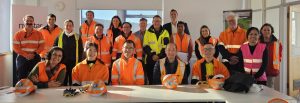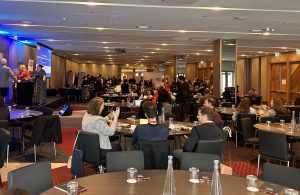![]()

What was probably the biggest event for Medical Practitioners with a career interest in OEM in Tasmania in recent years was held on Saturday 16 August in Hobart – a Worksite Visit Day. Our Victorian Colleagues led by AFOEM Vic/Tas Director of Training, Dr Joe Slesinger arranged an opportunity to visit the Nyrstar Hobart Smelter and the revamped Hobart Zoo & Aquarium (previously ZooDoo) with sponsorship from RedHealth and GP Collective (Dr Mark Baldock).
There were 7 Tasmanians amongst the 17 doctors (6 AFOEM Fellows, 9 AFOEM Registrars as well as two GPs), although in the intervening period one OEM Registrar has progressed to Fellowship. Congratulations to Dr Carlin White!
The participants had the opportunity for a guided tour of the Nyrstar site, thanks to Nyrstar’s continued interest and support for the training of doctors in OEM. Our appreciation to James Cherry and Cameron Crawford from Nyrstar who conducted us around the site.
This visit was followed by a visit to Hobart Zoo and Aquarium, providing an opportunity to understand the occupational risks for zoo keepers. Thanks to Stuart Webster, the new Hobart Zoo owner for his hospitality and insights into running a zoo. I had the opportunity to make a brief presentation about TFOM initiatives to the attendees.
Most importantly I was able to advise of a recent positive meeting with Government representatives where the need for support for OEM training was recognised.

Last Friday I attended another significant annual event held in Hobart – The Australian Insurance Law Association’s [AILA] Workers Compensation Masterclass.

This is an informative and popular event attended mainly by lawyers and claims managers with the occasional doctor and rehabilitation provider also in attendance. This years event was well attended (as usual) with more than 100 attendees (my estimate), to hear about the complexities of calculating income support payments and how the legal system manages party/party costs. For me, rather than trying to understand the complexity of how Normal Weekly Earnings are calculated, I ask why does it need to be so complicated?
Another presentation interest was that of Dr Michael Evenhuis, Consultant Psychiatrist about how the Psychiatric Impairment rating Scale [PIRS] is used to calculate Whole Person Impairment [WPI] due to Psychiatric / Psychological injury. The take-home message for me was that there is a large jump between the moderate to severe impairment categories and that the definitions of pre-existing psychiatric impairment (that are deducted from ratings for current impairment) are somewhat different than those for physical injuries, where only symptomatic pre-existing impairments are deducted (and only where there is objective evidence).
As always, the highlight of the event was the presentation by TASCAT Deputy President [DP], Mr Richard Grueber who provided information about the operations of TASCAT’s Personal Injury Stream. Of interest in the 2024-25 year there were 885 Section 81A referrals (Disputed Claims) out of a total 1892 referrals under various provisions of the Workers Rehabilitation & Compensation Act. A high rate of disputation is an indication of system dysfunction, I suspect.
Mr Grueber made a presentation on the subject of Sovereign Citizens, a current topical matter given the events unfolding in Victoria. He also highlighted the legal uncertainty surrounding ‘privileged communications with medical practitioners’ citing various provisions of the Evidence Act and the TASCAT Act. He suggested this matter needs clarification by a higher legal authority i.e. the Supreme Court – so the obligations of a medical practitioner summoned to provide a copy of their medical records remains unclear.
Finally, I had the opportunity to submit a pre-prepared question to the meeting organisers, who passed it on to DP Grueber to answer.
I would like to submit the following question:
Look around you “at the AILA RedHealth Workers Compensation Masterclass Audience” and compare the image to the attached photograph taken about 2 weeks ago at Nyrstar in Hobart. It is a photograph of the attendees at the biggest gathering in recent years of Tasmanian Medical Practitioners who have a career interest in Workers Compensation (including Workplace Health & Safety & Rehabilitation) noting that most of the attendees are Victorian, and of the 7 Tasmanians in the photo, 2 are nearly 70 years of age. What does this mean for the future?”
![]()
![]()
![]()
![]()
![]()
